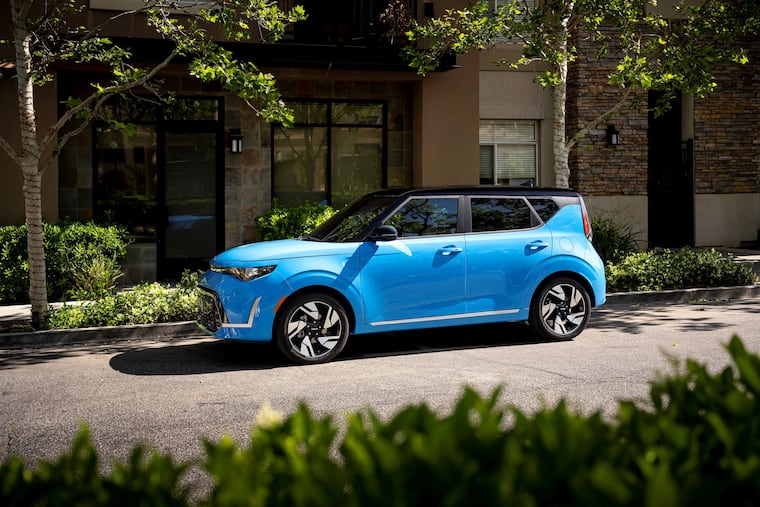Kia Soul 2023 GT-Line: Not the same old Soul
The little box from the popular Korean carmaker takes on a brand new rendition of its cousin Kona from Hyundai. The Soul has soul but lacks in some critical areas.

2023 Kia Soul GT-Line vs. 2024 Hyundai Kona: Battle of the tiny, low-price SUVs from Korea.
Price: The trim level starts at $23,490.
A basic Soul can be had for under $20,000, in theory. There may not be many available (un)equipped like that, but that’s an intriguing price point.
Conventional wisdom: Car and Driver likes that it “stands out in traffic, spacious interior, strong value proposition,” but not that it “could be more fuel efficient, all-wheel drive is unavailable, poky four-cylinder powertrain.”
Marketer’s pitch: “All around good looks.”
Reality: Renewed Soul.
What’s new: The Soul gets a new look, new colors, and a simplified lineup.
On the disappointing side, the turbocharged engine is gone, and so is the stick shift.
There is also a Soul EV, which I’d like to try, and seems to be more of a dream than an actual car I’ve ever seen anywhere.
Competition: In addition to the Hyundai Kona, there’s the Buick Encore, Chevy Trailblazer, Jeep Renegade, Mazda CX-30, Volkswagen Taos, and many more.
Soul to Soul: There have been so many Souls in my life I could be the new Godfather of Soul. The Lovely Mrs. Passenger Seat drives a Soul, and before this Soul had an old Soul. Sturgis Kid 3.0 also is a Soul survivor. We’ve tested other Souls for purchase and had friends with Souls, and I’ve tested them over the years for this column.
Bye-bye to rocky roads? The one common theme of the Soul is that it’s a rough ride. They’ve gotten better over the years, but there’s just no great way to turn a miniature delivery van into a gliding sports car.
But Kia is getting ever closer. The GT-Line that I tested smoothed things over immensely; the bumps and shifts in country roads are much easier to endure than in earlier years.
Up to speed: The Soul has never been a rocket. That is even more true for 2023, with just a 2.0-liter four-cylinder engine available. Its 147 horsepower moves the box to 60 mph in a poky 8 seconds, although cooperation while rolling around town and country is amazing, especially considering the price point. It’s only in real full-on acceleration — getting onto a highway, pulling into traffic — that you feel a little challenged. The car even climbs some steep Chester County hillsides with ease.
Here again, smoothness is on the Soul’s side. Our own Soul’s accelerator can seem a little uncertain at times, but this model seemed to just ease on down the road.
Shiftless: I’m not usually a CVT fan, but I think this unit’s calibration has made the most of those 147 horses. Operation is still through a shiftable lever, and it all works nicely.
On the road: The Soul GT-Line also provides nice handling on the curves and corners. The 18-inch wheels on the test model are the largest available, and they help add to the fun of the drive. Normal mode is fine; Sport adds the right amount of zip, but it revs the engine too high and became less than fun after a little while.
It would really be nice if all-wheel drive were available, especially because these big tires are going to be troublesome in the snow.
Driver’s Seat: Kia keeps attending to the details here and it pays off. The Soul now has a funky digital display for speed and rpms, clear and eye-catching. Controls and surfaces punch far above the Soul’s weight, with shiny ebony and graphene-like touches all around.
Friends and stuff: The boxy vehicle has always provided good room for passengers — tall Sturgis Kid 4.0 would have protested our buying one otherwise — and nothing has changed in this department. The seat has gotten nicer over the years as well.
Cargo space remains impressive, at 24.2 cubic feet behind the rear seat and 62.1 with the seat folded.
Play some tunes: The 10.25-inch touchscreen stands out nicely from the dash, and it’s easy to operate and to follow. Dials control volume and tuning.
Sound from the system has just gotten better over the years, and now reaches well into an A- and maybe even hits an A.
Keeping warm and cool: The Lovely Mrs. wants to give a shout-out to the bun warmers in the seats; they’re among the best her chilly side has enjoyed.
HVAC operation is simple as well: Dials for the temperature, plus buttons for the blower speed and location.
Fuel economy: Over 600 miles, including other drivers before me, the vehicle averaged nearly 28 mpg, which is better than we get out of our 2015. On a sedate trip over back roads to Newark, Del., I noted 33 mpg.
Where it’s built: Gwangju, South Korea
How it’s built: Consumer Reports predicts the Soul reliability to be a 3 out of 5.
In the end: The Soul remains a fairly nice deal for the money, although a little extra for a hybrid version with all-wheel drive would be an even better deal.
Next week: 2024 Hyundai Kona.